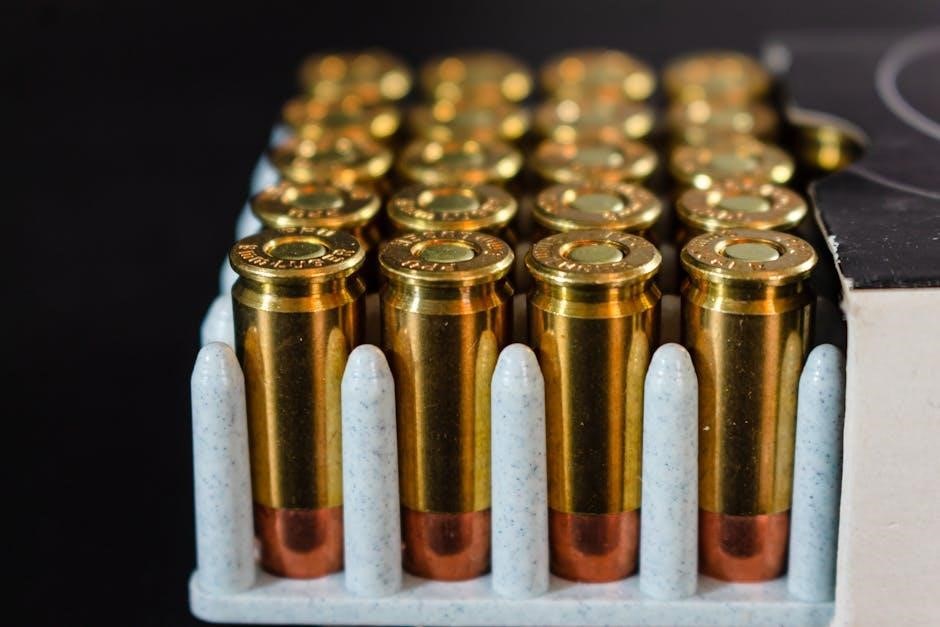Reloading shotgun shells offers shooters customization‚ cost savings‚ and improved performance․ With comprehensive manuals and precise load data‚ enthusiasts can craft tailored ammunition for various shooting needs efficiently․
Benefits and Basics of Reloading Shotgun Shells
Reloading shotgun shells offers cost savings‚ customization‚ and consistent performance․ By tailoring loads to specific needs‚ shooters can optimize patterns‚ velocity‚ and payload․ Essential components include hulls‚ primers‚ powder‚ wads‚ and shot‚ each requiring precise measurement and assembly․ Load data guides provide tested recipes for safety and reliability․ Understanding gauge-specific requirements ensures proper fit and function․ While initial setup costs can be high‚ long-term savings and improved accuracy make reloading a valuable skill for enthusiasts․ Proper techniques and safety protocols are crucial for successful reloading․

Essential Equipment for Shotgun Shell Reloading
Key tools include a reloading press‚ shell holder‚ powder measure‚ scale‚ and wad guide․ These ensure precise assembly and consistency in every reloaded shell․
Overview of Necessary Tools and Components
Reloading shotgun shells requires a press‚ shell holders‚ and a powder measure for accurate charges․ A scale ensures precise weight measurement‚ while a wad guide aligns components properly․ Additional tools include a crimper‚ deburrer‚ and primer pocket cleaner․ Components like hulls‚ primers‚ wads‚ shot‚ and powder are essential․ Each tool and part plays a specific role in ensuring safe and consistent reloads․ Proper setup and maintenance are crucial for achieving optimal results and preventing errors during the reloading process․
Safety Measures and Precautions
Always wear safety glasses and follow load data precisely․ Ensure proper primer installation and component compatibility․ Avoid overloading or using incorrect powders to prevent dangerous pressures and malfunctions․

Best Practices for Safe Reloading
Always wear safety glasses and a dust mask when reloading․ Follow load data precisely‚ ensuring component compatibility․ Avoid overloading or using incorrect powders‚ as this can lead to dangerous pressures․ Keep the workspace clean and well-lit‚ and store components separately․ Double-check primer installation and crimp depth for consistency․ Regularly inspect equipment for wear and tear․ Never reload in hazardous environments or near open flames․ Consult reputable manuals and start with small batches to test loads․ Adhere to SAAMI guidelines and manufacturer recommendations for optimal safety and performance․
Understanding Load Data for Shotgun Shells
Load data is crucial for safe and effective reloading‚ detailing powder charges‚ shot types‚ wads‚ and primers for specific gauges like 12‚ 20‚ and ․410 bore shells․
Importance of Load Data in Reloading
Load data ensures safety‚ consistency‚ and optimal performance in shotgun shell reloading․ It provides precise measurements for powder charges‚ shot amounts‚ and wad selections‚ preventing dangerous over- or under-pressure scenarios; By following load data‚ reloaders can achieve reliable ignition and consistent ballistics‚ critical for both target shooting and hunting․ Properly interpreted load data also helps maintain firearm integrity and performance‚ making it indispensable for all reloaders‚ from beginners to experts․ Always verify data from trusted sources to guarantee safe and effective reloading outcomes across all shotgun gauges and shot types․
Interpreting Load Data for Different Gauges
Load data varies significantly across shotgun gauges‚ requiring careful interpretation․ For 12-gauge shells‚ common loads include 1 oz․ to 1 1/8 oz․ of shot with specific powder charges․ The 20-gauge typically uses lighter loads‚ such as 7/8 oz․ to 1 oz․‚ while the ․410 bore requires even smaller shot and powder amounts․ Each gauge has distinct pressure limits and wad recommendations․ Reloaders must consult manuals or online guides to match their gauge‚ ensuring safe and accurate reloads․ Proper interpretation prevents over-pressure and inconsistent patterns‚ optimizing performance for various shooting applications․

Types of Shot and Their Applications
Shot types include lead‚ steel‚ bismuth‚ and Hevi-Shot‚ each with unique properties․ Lead shot offers dense patterns but is restricted in some areas․ Steel shot is non-toxic and cost-effective but harder‚ potentially damaging barrels․ Bismuth and Hevi-Shot provide excellent performance for waterfowl and long-range shooting․ Choosing the right shot ensures compliance with regulations and optimizes performance for specific applications like hunting or target shooting․
Lead Shot vs․ Non-Toxic Shot (Steel‚ Bismuth‚ Hevi-Shot)
Lead shot‚ traditional and effective‚ offers tight patterns but faces restrictions in many regions․ Non-toxic options like steel are eco-friendly yet harder‚ potentially damaging barrels․ Bismuth and Hevi-Shot provide dense‚ high-performance patterns ideal for waterfowl and long-range shooting․ Selecting the right shot depends on local regulations‚ target type‚ and desired performance․ Each option balances environmental impact‚ cost‚ and ballistic efficiency‚ ensuring shooters can adapt to various hunting and shooting scenarios while complying with legal requirements․

Reloading Process for Different Gauges
Reloading varies by gauge‚ with specific considerations for 12‚ 20‚ and ․410 bore shells․ Each gauge requires precise measurements and components to ensure safety and performance․
Specific Considerations for 12 Gauge‚ 20 Gauge‚ and ․410 Bore
Reloading for 12 gauge involves standard components‚ while 20 gauge requires precise load data and smaller wads․ The ․410 bore demands meticulous shot size selection and powder measurement due to its smaller capacity․ Each gauge has unique challenges‚ such as crimp depth and primer compatibility‚ ensuring reliability and performance; Load data must be carefully matched to avoid over-pressure or inconsistent patterns․ Understanding these nuances is crucial for producing safe‚ effective reloads tailored to each shotgun type․
Wads and Their Role in Shotgun Shell Reloading
Wads are essential components in shotgun shells‚ made from plastic or paper‚ serving to hold the shot and powder together for consistent and reliable performance․ Proper wad selection is critical for optimal results․
Choosing the Right Wad for Your Load
Selecting the correct wad is crucial for consistent shotgun performance․ Wads come in various types‚ including cup‚ sleeve‚ and cookie styles‚ each designed for specific loads․ For lead shot‚ standard plastic wads are sufficient‚ while steel or non-toxic shot requires specialized wads to prevent barrel damage․ Ensure the wad matches your shell’s gauge and shot type․ Proper fit and material ensure reliable ignition‚ consistent patterns‚ and optimal velocity․ Always consult load data manuals for compatibility and safety‚ as incorrect wad selection can lead to poor performance or hazardous conditions․

Primer Selection and Installation
Primers are critical for consistent ignition․ Choose primers matching your load data for optimal performance․ Proper installation ensures reliable firing and safe reloading of shotgun shells․
Matching Primers to Your Load Data
Choosing the right primer is crucial for consistent ignition and performance․ Always match primers to the specific load data in your manual to ensure safe and reliable reloading․ For example‚ 12-gauge shells often use Federal 209 primers‚ while smaller gauges may require smaller primers․ Verify manufacturer recommendations for compatibility with your powder and wad combination․ Incorrect primers can lead to inconsistent ignition or safety hazards․ Consult reloading manuals or manufacturer guidelines for precise guidance to achieve optimal results in your shotgun shell reloading process․

Troubleshooting Common Reloading Issues
Inconsistent ignition‚ improper powder charges‚ and incorrect wad placement are common issues; Consult detailed guides for solutions and ensure all components match load data specifications․
Identifying and Correcting Errors in Reloaded Shells
Errors in reloaded shells can include improper powder charges‚ incorrect wad placement‚ or inconsistent crimp depth․ Inspect shells for visible defects like loose shot or uneven seals․ Use calipers to measure crimp depth and ensure it matches load data specifications․ Correct issues by adjusting dies or replacing faulty components․ Always refer to reloading manuals for troubleshooting guides․ Pay attention to load data consistency to prevent over- or under-charged shells․ Addressing errors early ensures safety and reliability in reloaded ammunition․ Proper correction techniques prevent recurring issues and maintain consistent performance․
Resources for Advanced Reloading
Advanced reloaders can rely on detailed manuals like the Lyman Shotshell Reloading Handbook and Western Powders guides․ These resources provide comprehensive load data‚ techniques‚ and troubleshooting tips for expert-level reloading․
Recommended Manuals and Online Guides
For advanced reloading‚ the Lyman Shotshell Reloading Handbook and Western Powders Reloading Guide are indispensable․ These manuals provide detailed load data‚ techniques‚ and troubleshooting tips․ Online platforms like Hodgdon and Alliant offer searchable databases for specific calibers and shot types․ Manufacturer websites‚ such as Vihtavuori and Ramshot‚ also provide updated load data for various shotgun gauges․ Additionally‚ reloading communities and forums share practical advice and innovative approaches‚ helping enthusiasts optimize their shotgun shell reloading process for precision and performance․